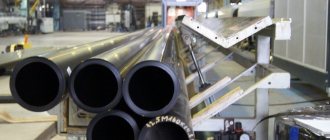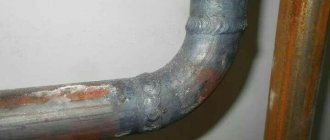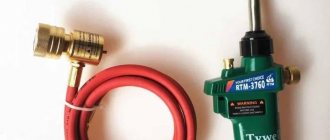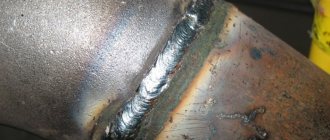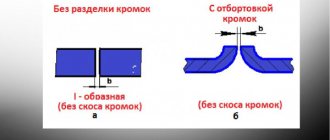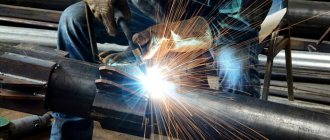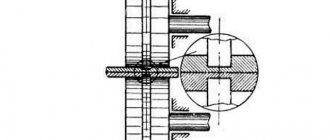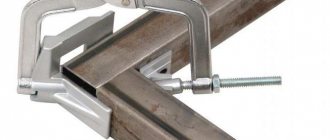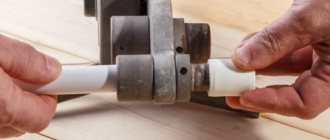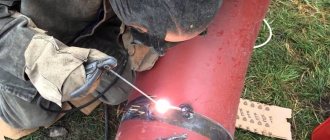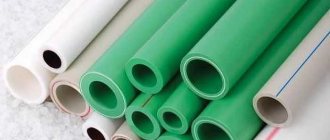Welding is a popular option for connecting pipelines. However, the technology for carrying out the work depends on the material used for its manufacture. Due to the widespread use of polyethylene pipelines, we will consider how HDPE pipes are welded. We will talk about the main methods for creating welded joints of individual parts of PE pipelines. Read and learn the features of each method. The information will help you stay on topic when communicating with professionals in this field.
Welding a polyethylene pipeline on the territory of a private house Source avito.st
General information
The method of welding when connecting polyethylene pipelines is in many ways similar to the method that is widely used when installing conventional or reinforced polypropylene pipes. In the latter case, the process is often carried out using a special soldering iron, the so-called iron with nozzles.
Such a tool can be used for soldering HDPE pipelines. However, it must be taken into account that low-density polyethylene softens greatly already at a temperature of +100°C. Its value for soldering pipes made of such material depends on the wall thickness of the products. Moreover, it is smaller than that of polypropylene parts. Often its maximum value is 200-220°C.
If it is 255-265°C, then the material will simply flow. After all, it is at this temperature that most polypropylene pipelines are soldered. Although the vast majority of models of polypropylene welding machines are equipped with a temperature regulator.
Special soldering iron with temperature controller Source gi-gas.ru
On a note! Soldering HDPE pipes with a soldering iron for polypropylene can only be done for products with a small or relatively medium cross-section. After all, such heating tools are produced by manufacturers with nozzles, the diameter of which is usually 16-160mm.
Welding of large diameter polyethylene pipes is carried out using specially designed welding machines. They are bulky equipment. Therefore, homeowners do not acquire ownership of it. Usually, if it is necessary to install polyethylene pipes, they turn to specialized companies. Moreover, specialists are well aware of all the features of pipelines made of such material and the technology of their connection.
When installing external utilities, it is necessary to lay pipelines, the diameter of which can reach 300 mm or even 400 mm. When connecting such products, professionals already use special welding machines. This is expensive equipment that allows you to create reliable, high-quality connections, even when joining thick-walled pipes.
Welding machine for HDPE pipes Source pokter.ru
Compared to steel, polymers, including low-density polyethylene, have better performance characteristics. It is also worth noting that HDPE is one of the types of polymers that is well joined by welding. Therefore, for such a material there are several ways to perform welding work.
On a note! Low pressure is a plastic manufacturing method, not a material parameter. After all, high-density polyethylene is still produced. This type of material is designed for 16 or even more atmospheres.
If welding of polyethylene pipes is mentioned, then we mean soldering of HDPE. This type of plastic is often designated by the Russian abbreviation PE and even the English letters PE. For high pressure material, the options used are PEHD or HDPE.
Leak test
Checking the quality of soldering is carried out only after all connections have been installed and cooled down. Why water is supplied to the installed system and the pipeline is inspected to determine leaks. Before adding water, it is necessary to let the installed system stand for at least an hour at normal room temperature, and if the air is at a low temperature, then a test run is carried out after at least 5 hours.
If loose connections are identified, then you need to drain the water and redo this part of the pipeline, using new fittings and selecting a piece of pipe of the required size. An attempt to somehow seal the connection is doomed to failure from the very beginning. Pipeline installation requires precise technology implementation.
After completing the repair, check the quality of the connection again by pouring water. If a heating system is being considered, then the pipeline can only be tested after the coolant has heated up when supplied under high pressure.
Methods for connecting parts of a polyethylene pipeline system
The connection of PE pipes is carried out using different methods. They allow you to create permanent and detachable joints. The specific option is selected taking into account the purpose of the system and its location.
Elements of pipeline systems from HDPE for creating permanent and detachable connections Source berezka-stroi.ru
A detachable connection is created when temporary pipelines are constructed. After all, this method allows you to disassemble the system after its operation. Detachable connections of individual parts of the pipeline network can be made using steel flanges.
More often, during installation of systems, permanent connections are created. This method allows you to make joints that are highly durable. The method involves welding individual parts of pipeline networks. At the same time, butt and coupling soldering has been developed and is widely used. Each option is a reliable and effective method. Thanks to these methods, it is possible to obtain a monolithic joint between two elements of the system. Therefore, each such connection has high strength.
Method 1 - socket welding method using fittings and couplings
To implement this option for soldering polyethylene pipeline elements, a special soldering iron is used. Manufacturers make this device with a set of attachments. Their diameter corresponds to the standard sizes of HDPE pipes.
Soldering iron for socket (socket) connection Source ugra.ru
The welding process usually involves the use of fittings. These products include various angles, couplings, tees, manufactured with different standard diameters. All such parts are connecting elements. They are welded to the ends of straight pipe sections.
The design of a soldering iron for polyethylene pipes includes metal elements that heat up during operation of the device. They are the ones who heat up the HDPE products being connected.
The inner surface of the fitting is heated by a mandrel. The outer part of the PE pipe is heated by the sleeve. It is into this that a straight section of the pipeline system is inserted. The sleeve together with the mandrel are placed on the soldering iron. There are holes in the device for this purpose.
Using a special soldering iron, polyethylene pipes are often soldered inside and outside a private house. Usually specialists are invited to carry it out. After all, not every homeowner is familiar with all or at least some of the nuances of welding polyethylene pipeline elements.
Laying HDPE pipelines outside the house Source remontnik.ru
Before the welding process, a number of preparatory work is always carried out. The following operations must be carried out:
- The pipes are cut to the required length using specially designed scissors. After using them, you should get a cut that is strictly perpendicular to the axis of the product.
- The end parts of the parts to be joined are cleaned of any foreign particles.
- The ends of the system pipes that are not currently involved in the welding process are closed with plugs of a suitable size. This will allow the heated parts of the pipelines to stay cool longer and prevent contamination of their internal cavities.
- The heating surfaces of the soldering equipment are cleaned of all contaminants, including plastic particles that often remain on such parts of the device after use.
After all preparatory measures have been carried out, the HDPE pipe is soldered for water supply or communications for other purposes. However, most often the installation of polyethylene pipelines is performed when creating systems through which water from the source moves into the house.
Installation of external water supply from HDPE pipes Source wixstatic.com
See also: Catalog of construction companies that have their own production of materials and components for the construction of houses
The soldering process itself is carried out as follows:
- Parts of soldering equipment are heated to the required temperature value. The required degree of heating is determined by a special indicator on the device. An audible alarm may sound when the set temperature is reached.
- The straight section is placed in the sleeve. Its insertion is carried out until it stops. In this case, the fitting is also completely put on the heated mandrel. Most often, some effort is required to connect pipeline parts and equipment elements.
On a note! When the pipe is inserted into a heated nozzle, a roll of molten polyethylene forms on it. The material is extruded directly by the hot sleeve.
- The heated fitting is placed on the heated pipe. In this case, the two parts are connected to the annular bead, which formed on the straight element during its heating. It is a kind of guideline that allows you to avoid squeezing the connection. Otherwise, the flow area of the utility line at the junction of two parts may decrease.
The process of heating and connecting a fitting to a pipe Source alexmafuer.com
At the end of the entire process, wait until the connection cools down. During this period, ensure complete immobility of the joint. It is in this sequence that the correct welding of PE pipes using the socket method is carried out.
There is no need to put in much effort when implementing this method. However, during sleeve welding, specialists always take into account the standard heating periods of parts. The heating time of pipes and fittings depends on their diameter. The duration is also affected by the wall thickness of polyethylene products.
In addition, the two parts being connected are never squeezed. The reason for this is not only the possibility of narrowing the cross-section of the communication, but also reducing the strength of the joint.
On a note! To prevent the pipe from being crushed during its insertion into a heated sleeve, the depth of the free space in the fitting is marked on it in advance.
Before heating and joining pipes, it is recommended to mark the depth of the connection on them. Source gadgethacks.com
Method 2 - butt welding
When implementing this method, a special welding machine is used to weld polyethylene pipes. The method itself is used to connect parts made exclusively from low-density polyethylene. This is a universal method because this option allows you to maintain the flexibility of the entire pipeline system, regardless of its length. In this case, installation of utility lines made of polyethylene can be carried out in the ground or on its surface.
Butt welding of HDPE pipes is a rather complex process from a technological point of view. It must be performed by an experienced craftsman. Docking using this method is carried out in stages and strictly in a specific sequence:
- The ends of the pipes are placed in a centralizer of special welding equipment.
- Pipeline products are first aligned and then securely fixed in the welding machine.
- Dirt, grease particles, dust and other foreign debris, including various deposits, are removed from the connected ends of the pipes. Cleaning is done using cotton material, which is pre-moistened with alcohol.
Before making butt joints, all dirt is removed from the ends of HDPE pipes Source gazplast.ru
- The ends of the joined products are processed with a trimmer, which is a special device designed to remove a small layer of polyethylene. The device is used until uniform chips appear, the thickness of which should be no more than 0.5 mm.
- The treated parts of the pipeline system are removed from special equipment to check the parallelism of their ends. This process is carried out by eye and hand after connecting two parts. If a significant gap is detected between the pipes, then the end surfaces are re-aligned using a special device.
- The ends of the trimmed workpieces are heated by a heating element of welding equipment specially designed for this purpose. The surface of this part of the device is distinguished by the presence of a non-stick layer.
- PE pipes are butt welded as soon as their ends begin to melt slightly upon contact with the heating element, which is immediately removed. After this, the ends are closed.
Butt welding of polyethylene pipeline Source 2gis.com
Important! The pressure with which the two pipes are pressed against each other must be increased until a strong connection is formed. After this, the two parts of the piping system to be joined are left motionless for at least 5 minutes so that the seam between them is completely hardened.
- The quality of the created connection is checked by visual inspection. The alignment of joined pipes is assessed. In this case, the strength of the weld must be checked.
Important! Before soldering HDPE pipes, preparatory work is always carried out. They are carried out with special care, because the reliability and strength characteristics of the joint being performed will depend on their quality.
Effective methods of joining HDPE pipes
Technologically, HDPE pipes can be connected using two main methods – one-piece and detachable.
The first involves the use of a welding machine, the second is implemented without using one.
Each fastening method has its own advantages and disadvantages, and therefore the optimal option for joining polymer pipes is chosen based on specific conditions
Welded permanent connections enable maximum sealing, which is especially important when constructing pressure lines. Detachable connections are easy to install and make it possible to disassemble the pipeline at any time in order to change the configuration of the main line or add new bends to it.
Video description
This video will help you clearly understand the process of connecting polyethylene pipes using butt welding:
Method 3 – electrofusion welding option
This method differs from the method when soldering HDPE pipes with a soldering iron. This option involves the use of electric couplings rather than simple fittings. The method is specially designed for connecting straight sections of a polyethylene pipeline system.
An electric coupling is a special fitting. It has embedded heating elements in its design. Manufacturers also produce connecting elements in the form of tees and other designs, each of which is equipped with spirals for strong heating of polyethylene.
On a note! The plastic from which the coupling is made heats up greatly and even expands, which allows it to connect with the polymer of the pipe. The result is a structure with a monolithic structure.
Electric couplings are quite expensive fittings. The cost of such parts for pipelines can be 100,000 rubles. or even more if the system has a significant diameter. This statement is relevant for fittings whose cross-sectional size exceeds 600 mm. However, soldering of large-diameter HDPE pipes is rarely performed on the territory of a private house.
Polyethylene electrocoupling Source agruamerica.com
A significant advantage of using electric couplings is the absence of burr, which is formed when soldering is performed by other methods. Therefore, the utility communication capacity does not decrease.
On a note! Burr is molten polyethylene, which, after connecting two parts of the pipeline system, hardens and forms streaks. From the outside they can be removed quite easily, but inside the pipes it is difficult or even impossible to get rid of them. Leaks can cause a decrease in communication throughput.
Polyethylene pipes are connected by welding and using an electric coupling in the following sequence:
- A piece of pipe of the required length is prepared, which will be connected to the polyethylene communication.
- The welded areas on the pipes and in the electric coupling are cleaned of debris and dirt, and also cleaned to remove the oxidized layer.
- Places are marked on the pipes to be connected that allow you to control the depth during their insertion into the electric coupling.
- The open ends of the piping system are sealed with plugs to prevent rapid cooling of the welding site.
- The parts are connected into a single unit.
Assembling a unit from two HDPE pipes and an electric coupling Source veld-plast.ru
- The welding machine is connected by two wires to the electric coupling.
- The welding process is started by pressing a special button on the equipment.
- Wait until welding is complete. It depends on the size of the parts being connected.
On a note! After the allotted time has elapsed, most models automatically turn off.
Upon completion of the welding process, the heated and molten polyethylene will harden for at least 1 hour. Only after this time will the material gain strength and the pipeline can be used for its intended purpose.
Work process
We must not forget that welding work on polymer materials must be carried out under the condition of sufficient ventilation of the room. When heated and melted, polymers release toxic substances that, when concentrated, have a strong effect on the human body.
Before soldering a polyethylene pipe, you need to perform the following preparatory procedures:
- It is necessary to place blanks of the required size on the heating element plateau.
- Afterwards, the temperature sensor must be set to 250ºС.
- Then it is necessary to prepare the parts to be joined (treat with a degreasing compound, remove the chamfer).
- Connect soldering equipment.
- Wait until the welding machine reaches the required temperature (the green indicator should light up).
Afterwards, the parts to be connected (pipe-coupling) are simultaneously placed on the soldering iron blanks. Moreover, the pipe must be inserted into the inner part of one blank, and the coupling onto the outer surface of the second.
As a rule, the ends of the pipe are installed at the boundary of the previously marked line, and the coupling is inserted until it stops. We must not forget about the holding time of parts.
If the holding time is insufficient, it is possible to obtain an insufficient degree of diffusion of the parts being joined, which will affect the quality of the soldering. If you exceed the melting time, this can lead to disruption of the structure of the parts being connected and also does not guarantee high-quality soldering. That is, it is necessary to use special tables that indicate the optimal time for pipes with different technical characteristics.
After the required conditioning of the joined elements on the blanks, the parts are removed and connected to each other by heated sections. The joining process must be carried out quickly and accurately, maintaining the alignment of the elements being connected. It is allowed to make small adjustments along the axes (for 2-3 seconds), but it is prohibited to rotate the connected parts relative to each other.
It must be said that the indicated soldering time for any pipes may differ depending on the work conditions and the characteristics of the material. For example, if soldering is performed at subzero temperatures, then the specified standards can increase to 60%, taking into account the nominal value. For all individual conditions, the heating time is selected using test soldering.
Selecting a welding method
The working conditions influence the method of soldering when connecting individual elements of polyethylene pipeline systems. The appropriate option is selected taking into account the pros and cons of a particular method. Other factors that are of considerable importance are also taken into account.
So, if it is necessary to create the most flexible pipeline system, polyethylene pipes are butt welded. This option will eliminate the formation of individual hard sections. This method is also economical and simplest to implement.
The electrofusion method is the most expensive method. It is well suited for hard-to-reach areas where space around the pipeline is very limited. Another advantage of this option is its high technology. It provides the required connection quality, which never has to be redone.
Electrofusion welding option Source smartsk.ru
On a note! In many summer cottages, detachable connections of HDPE pipes are performed. This option for joining polyethylene products is used if, for example, a temporary system for watering certain beds is created. This method is also used when you need to quickly complete a one-time job.
The socket welding method, when simple couplings or other fittings are additionally used to branch the system, is suitable for cases where it is necessary to connect individual communication elements in hard-to-reach places. In these areas it will be impossible to implement the butt method. In many cases, special equipment will not even fit in such places. In addition, at these points in the system it is almost always impossible to perform axial displacement of the parts being welded. Therefore, the only option is to use a special soldering iron.
Possible mistakes
Carefully thought out and unhurried movements are a guarantee of avoiding mistakes. It is necessary to take into account all the features of the technology and fully comply with them.
The most common mistakes that result in the formation of defective components of the pipeline system being laid are as follows:
- The cutting angle of the parts being connected differs from 90 degrees.
- The surface has not been cleaned from greasy film.
- Insufficient or excessive heating of the elements being connected.
- Loose installation of the product inside the fitting.
- Adjustment of the joined parts after the polymer has hardened.
- Incomplete removal of the reinforcement layer.
In some cases, on high-quality materials, strong heating does not show visible defects. But at the same time, internal deformation occurs, in this case the molten plastic blocks the internal passage of the pipeline. Subsequently, this unit loses its functionality - it quickly becomes clogged and blocks the movement of water.
If the cut of the ends differs from the value of 90 degrees, then when connecting the elements they lie along a beveled plane. A misalignment of the joint appears, which is noticeable when several meters of the pipeline have already been laid. This often means that all the work needs to be re-done from the beginning.
Poor degreasing of the ends contributes to the appearance of “rejection islands”. In these places, the polyfusion connection does not occur completely. A pipeline with this defect can work for a certain time, but a leak may appear at any time.
The same result can be achieved by connections made with incomplete cleaning of the reinforcement layer. Most often, reinforced pipes are installed in areas of high pressure. The remaining aluminum foil in the soldering area creates a non-contact zone. This area is often a channel through which water flows.
Briefly about the main thing
Welding polyethylene when connecting individual elements of pipeline systems can be performed using a soldering iron for polypropylene. However, it is used for joining small diameter pipes. It is often even used in non-critical areas.
Higher quality welding is performed with equipment that allows pipes to be joined end-to-end. They are placed in a centralizer, aligned, secured, heated and joined under pressure.
An even more high-tech method is the use of electrofusion couplings. They are distinguished by the presence of built-in heating elements that melt polyethylene after connecting to the equipment.
Regardless of the method, the parts being connected, piping systems are first cleaned of any dirt. If necessary, their ends are cut strictly perpendicular to the longitudinal axis.
Recommendations from experts
Soldering of pipes must be done in a room with a positive temperature: the colder the air, the longer it takes to warm up the parts. For a strong and tight connection, you need to pay attention to the following recommendations:
- Equipment for domestic use is used to work with pipes with a cross-section of up to 35 mm; in other cases, you need to use a professional soldering machine.
- The power of the tool for home use must be 1500 W.
- There is no need to press the parts together tightly. Because the molten material will be forced inward and reduce the fitting bore, this will in turn reduce the performance of the system.
- Before you start soldering, you need to warm up the device for at least 15 minutes.
- After any soldering operation, you need to clean the nozzles from traces of plastic. This will prevent the formation of carbon deposits, as well as damage to the parts that need to be connected. The nozzles must be cleaned using a wooden stick. It is forbidden to use metal objects, as scratches will damage the nozzle, and plastic pipes will constantly stick to it.
- Do not leave gaps between the inside of the fitting and the edge of the pipe. This pressure weld will create a leak.
When deciding to do the work yourself for the first time, it is best to purchase material with a certain reserve. Knowing only theoretically how pipes can be soldered correctly, you need to practice before starting installation. If the experience was not entirely successful, then it is better to entrust the installation of the pipeline in the house to specialists .
general information
Any DIY welding of plastic pipes depends on the type of plastic used for it. There are three main types of plastic materials:
- polyvinyl chloride products used as a cheap type of plastic to reduce the cost of pipeline repairs;
- polyethylene materials used both inside buildings and as external pipelines capable of withstanding negative ambient temperatures and high water pressure inside them;
- products containing metal (metal-plastic), which are particularly reliable and durable, last more than 50 years and are used for the basis of hot water supply pipelines.
Necessary equipment and tools
Tools
Soldering pipes made from HDPE is impossible without the use of a number of special devices. The most important thing in this case is the welding machine. It is a special device that contains a heating element. Holders for various attachments extend from this element. It is these nozzles that are used to melt the material.
Butt welding of polyethylene pipes also requires special measuring and alignment components. They are necessary for clear fixation of products opposite each other.
Typically, cooking appliances are not used at home. They are used in industry, as well as by professional plumbers. This is due to the increased complexity of such work and the risk of leaks. But sometimes such work can be done with your own hands. After all, if you follow simple rules, then all risks will be minimized.
Along with a soldering iron, you may need:
- roulette;
- professional pipe cutter;
- means for degreasing and cleaning surfaces;
- marker for making marks.
Scissors or a pipe cutter often come with a soldering iron, so you most likely won’t have to purchase it separately.
For sleeve welding, you will also need a separate set of fittings of different sizes. These can be straight or angular couplings, taps, distributors or tees.
Other pipe soldering tools are also sometimes used to help the craftsman complete the job as efficiently as possible.
Gluing with acrylate glue with filler
The best glue is Weicon Easy-Mix PE-PP. It is specially designed for materials with weak adhesion. Most liquids “stick” to polyethylene very poorly and are simply squeezed out from the point of contact between the surfaces.
But this glue contains the addition of tiny glass beads, which prevents the glue from leaving the gluing area, forming a gap of the required thickness. Therefore, the gluing surface is sufficient and the glue, when hardened, holds the surfaces firmly together. It’s hard to find anything better than gluing polyethylene.
Surfaces must be thoroughly degreased and dried before gluing. Glue can only be supplied from a branded packaging mixer. The best temperature for performing work is +21…+23 °C. Liquid glue is good for no more than 2-3 minutes. After applying the layer, you must immediately join the surfaces. Full readiness of the seam (maximum mechanical strength) for polyethylene will be achieved in a few hours (4-5 according to the experience of those who worked with glue). The curing of the adhesive joint is carried out at a temperature from +15 to +70 degrees.
Reasons for the uniqueness of PE
We can talk about the noticeable rigidity of high-density polyethylene pipes. This is due to the strong bond of this product at the molecular level. For this reason, the production is considered extremely durable.
The main advantage of low pressure PE is that it is made from petroleum. This material is resistant to low temperatures, does not emit harmful substances into the environment and is not considered dangerous to people.
According to their purpose, the following types of high-density PE pipelines are distinguished:
- Technical (used in sewerage, gas supply and cable production);
- Food grade (suitable for designing drinking elements).
Depending on the connection method, there are detachable (easily disassembled after soldering) and permanent (they cannot be disconnected; they are used at high pressure).
